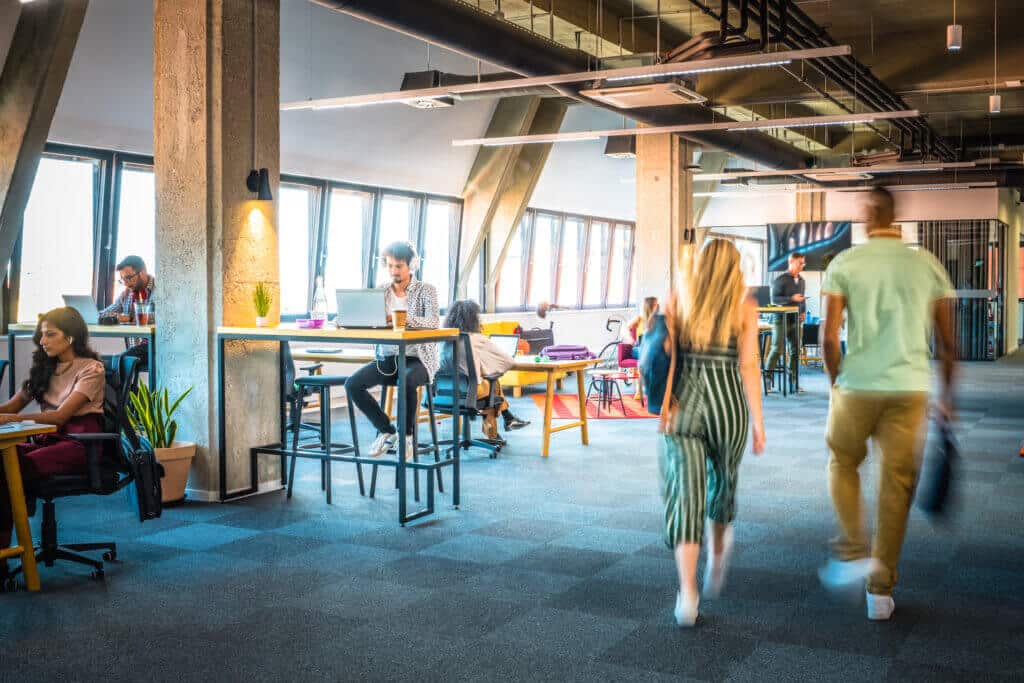What space type is best for your employees?
It might sound like a simple question. And in the days of the traditional, Monday-to-Friday, 9-to-5 workplace, it often had a simple answer.
But of course, hybrid work demands more flexible working options, which in turn demands more flexible seating choices. Aligning diverse hybrid schedules in a way that improves both company performance and workplace wellbeing is no easy task.
And as the OfficeSpace 2023 Workplace Strategy Report makes clear, hybrid work also demands highly enriching and engaging collaboration spaces.
So perhaps the better question today is what workspaces will actually enhance your hybrid office for people who use it?
In this article, we explore space types and how they intersect with the future of work. This will include a breakdown of different types of spaces in the office. Also, how to choose the best setup for your people, your budget, and your business goals.
What is a ‘space type?’
In a physical office setting, a ‘space type’ is any area of the office that is dedicated to work and/or employees. In other words, space types are work areas, designed around the types of activities done there or the employees who use them (or both).
When planning or optimizing space types, facility managers (FMs) and other space planners are typically looking to increase employee engagement and productivity, while also keeping corporate real estate costs in check. They tend to rely heavily on a variety of popular work environment types when designing their offices, including:
- Traditional work environments, designed for full-time office workers (and often filled with cubicles and private offices)
- Open offices, a more modern office floor plan on the opposite end of the spectrum, with primarily open spaces and shared tables instead of desks
- Office neighborhoods, which use office neighborhood software to split up the office layout for a variety of different teams, based on their needs or preferred working styles
- Activity-based workspace design, which allows for activity based working, where employees can move around the office depending on the type of work (i.e.: the activity) they’re performing
- Agile work environments, the most flexible and employee-centered type of work environment, which creates work environments individualized to the people using them
Once they’ve determined the right work environment, FMs can then determine the specific space types needed therein.
And as we’ll explore more below, using workplace data to determine what spaces to offer should be an essential part of your facility planning process.
The rise in bookable space
When employees aren’t in the office each day, they don’t need dedicated seats or cubicles like in the past. So along with the rise of hybrid work, we’re also seeing a rise in bookable spaces.
That’s why many hybrid offices now allow employees to book both desks and rooms. Doing so helps them to optimize their real estate portfolios while keeping the hybrid workplace experience high.

What are the 3 types of space?
Using data and surveys to ascertain how (and even why) employees work is ultimately the best way to develop the types of workspaces that will help them do their best work.
That said, in modern and/or hybrid office environments, most companies lean towards one of the three primary uses of office space.
1. Collaboration space
Creating more spaces to support collaboration in the workplace is quickly becoming a focus for many hybrid leaders. Whether employees are brainstorming, working on a shared project, or simply chatting about last night’s game, we know that collaboration has ripple effects on business success and employee satisfaction (making it important for talent retention efforts, among other benefits).
We also know that there’s a qualitative difference between remote and face-to-face interactions.
That’s why it’s not surprising that, according to the OfficeSpace Workplace Strategy Report, which surveyed over 150+ workplace leaders and analyzed thousands of data points from our 1000+ users, collaboration and culture are quickly becoming the main drivers for office use today.
Indeed, leaders are evenly split on whether to mandate office use. But they’re not split on the benefits of face-to-face collaboration. 65% of leaders report they want people in the office primarily to improve collaboration. 59% want people in the office to improve culture, too.
The result is that many leaders are now hoping and working to position the office as a space that enhances meaningful collaboration and connection.
This usually requires informal collaboration areas for general chatting. It also requires formal areas and conference rooms arranged specifically for collaboration. These may include unique flex room ideas, as well as break-out spaces, lounge areas, huddle rooms, and a variety of meeting room setup styles.
2. Heads-down space
Many hybrid employees enjoy working from home specifically for the peace and quiet it offers. They’ll leave their focus activities for home, and their group activities for the office.
But of course, for some employees, it’s just the opposite. Roommates, children, pets, and noisy neighbors can all make working from home more challenging than it’s often worth.
And some people just prefer being in the office, even for solo work.
For these reasons, even when companies focus on making their office a collaboration hub, they may still opt to provide private single spaces for heads-down work.
Examples of this type of ‘me’ space include cubicles, focus booths, private phone booths, quiet rooms, and private offices.
3. Flexible space
Finally, every office is going to have unassigned spaces, like lunch rooms, hallways, bathrooms, and foyers. Work may not specifically get done here. But the design and cleanliness of this general use space can still very much impact the desirability of working in the office.
Note that while not specifically work-related, employees will still need access to many of the resources housed in these spaces. That’s why, for example, things like filing cabinets, reception, eye wash stations, water coolers, and more can all be added to floor plans within OfficeSpace’s Visual Directory.

How to choose and optimize your space type
When trying to establish what mix of space types you need, it’s important to remember that every office culture is different. There’s no one-size-fits-all solution.
“We’re all still figuring out what workplace design and our workforce strategies should be,” says OfficeSpace CEO David Cocchiara in a recent discussion about the Workplace Strategy Report. “We’re in a space right now that is in a unique, once-in-a-lifetime, once-in-a-career transition. You’re not alone—the nature of space and the workplace is in flux right now for everyone.”
That said, most offices will require a mix of all three space types. This is in order to provide a workplace that supports optimal workflows. Employees need a lot more than comfortable seating and some natural lighting these days. They also need easily accessible flexible space that is designed for the way they actually use the office.
And companies can only really offer this type of highly optimized space when high quality data is part of their planning process.
The importance of both surveys and workplace metrics
Employee surveys are important. While discussing culture in the workplace, Cocchiara also stresses the importance of bidirectional communication with employees.
“Bidirectional, open communication that is going to produce the best work and the best culture in the long term,” he says.
But surveys will only go so far. People generally aren’t the best analysts of their current office use, nor the best predictors of their future behavior.
That’s why companies also need to collect workplace metrics. This will help them determine how, when, and where people are using the office.
And the more data they can collect, the better (assuming it’s combined into actionable and understandable workplace reports and analytics).
For this reason, space planners will want to collect data from as many sources as possible. This is including (but not limited to) employee badge data, room and desk bookings, wifi logs, IoT sensors (including and especially occupancy sensors), and HR data.
In the past, companies may have collected some of this data. But it often sat in silos and/or was left unanalyzed. To be useful, companies will need to break down these silos. This way, decision makers can better understand their current and future space needs.

Space types that support hybrid and remote employees
Finally, companies with remote and/or hybrid employees will need to consider their space needs as well. Do they have access to a space type at home that supports their work? Does space that include reliable wifi and digital workspace? If not, companies may want to consider offering employees a stipend to help them optimize their personal space.
Moreover, employees who are in the office less frequently may benefit from a more comprehensive wayfinding system than those who are there every day.
Like we’ve covered, bookable spaces can help them to use the office on an as-needed (or as-desired) basis. Ideally, robust desk booking software and room booking software will make this process as simple as possible.
Better yet, if along with bookable spaces, employees are also able to access a visual directory like Who’s In, a feature from OfficeSpace that helps employees find the people, places, and resources they need in real time, from their preferred platform or mobile device
Let space follow need
When developing a space type strategy, the most important considerations should always be the users of that space. Identify employee needs first, and the right types of spaces will follow.
OfficeSpace can help determine what space types you need for your employees. Reach out for a free demo.
Photos: skynesher, vm, Edwin Tan, filadendron




